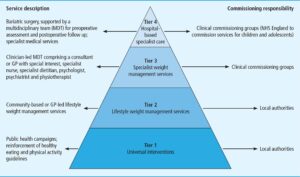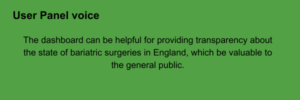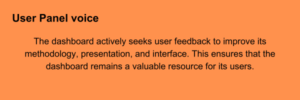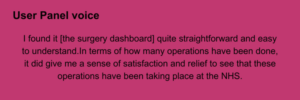Engaging with people for the National Obesity Audit (NOA)
Direct to the NHS England Bariatric Surgical Procedures Dashboard
Dashboard guidance for the public
HQIP is engaging and collaborating with people on the National Obesity Audit.
In April 2022 we set up a User Panel of 20 people with experience of overweight and obesity, they have shared their stories about the care and treatment that has been available to them or loved ones as well as their experience of services. More about the user panel can be found below.
The following work has been co-produced with the User Panel.
Introduction to the National Obesity Audit
Background
Nearly two-thirds of adults in England are living with overweight or obesity. The National Obesity Audit aims to gather information about the care they receive, the results or “outcomes” they achieve, and help to improve services in the future.
This project is funded by NHS England and began in 2021 and is continuing to develop. At present the audit is focused on making use of information or “data” already collected from hospitals, community settings (such as Weight Management Services) and general practices (GPs) across England.
The primary audience for the NOA data analysis at present is those who work in healthcare services delivering care to people with obesity. However, we know that service users, carers and members of the public often want to understand the information that is publicly available, particularly what could be relevant to the obesity programmes and care they are considering or receiving. This is why we have created this guide.
What information is being used?
At present, the focus is on three main types of data that cover the main services that people living with obesity could access. These are:
- Data from NHS hospital records – the NOA project is analysing data about people undergoing bariatric surgery for obesity in the NHS from 2018-2023. This is sometimes called ‘HES’ data, meaning Hospital Episode Statistics.
- Data from community settings (such as Weight Management Services and interventions funded by local authorities) – the NOA project began to use data from the Community Services Data Set (CSDS) in 2023. Not all community settings are submitting data to the dataset yet, and so the data is rather limited, but this data is starting to be used.
- Data from GP records – the NOA project hopes to be able to start using GP data (via the Cardiovascular Prevent Audit) in 2024 to understand who is recorded as living with overweight and obesity. It will also look at what information is being given; which services they are referred to; and information about patient ethnicity and age.
We will update this page with further information as this develops.

What information is publicly available?
There is information on bariatric surgery undertaken across England from 2018-2023 published in the form of a ‘dashboard’. We have created a specific guide to help with using and interpreting the dashboard. The dashboard includes information about;
- Number of people who undergo the surgery at each NHS and some private hospitals
- Procedure types
- Demographic breakdowns by; age, deprivation, ethnicity, gender and severe mental illness
- Average distance travelled to treatment
- Length of stay at the hospital by procedure type
In future, more community services data is due to be published and this will provide more information for service users and members of the public.

Future aims
The NOA has ambitious plans to collect, link, analyse and report routinely recorded data across the entire weight management pathway (GP – WMS – hospital care). Ultimately, the NOA aims to encourage improvement of the identification and care of people living with overweight and obesity.
In the future the hope is that the NOA dashboards will be able to show much more information about how people access services and the results and changes to people’s health afterwards (both short term and long term). It is important to understand this so that each service can see how well they are doing compared to others and understand where they may need to make improvements.
Dashboard
To help understand the surgery dashboard, we have created a complementary resource to help you view the dashboard, this includes a description of the different bariatric procedure types and a glossary.
If you have feedback about the dashboard, there is a survey here:National Obesity Audit (NOA) publication – Feedback Form (office.com)
Other links and information
NHS England – National Obesity Audit dashboards – https://digital.nhs.uk/data-and-information/publications/statistical/national-obesity-audit
For general information about the National Obesity Audit see: National Obesity Audit
If you have comments or questions about the audit contact – [email protected]
For further information about the NOA User Panel contact [email protected]
User Panel
The User Panel is made up of 20 people from across England who are users of services or are carers and families of people living with overweight and obesity.
We are so grateful for their input, which influences the way the audit develops and functions. The panels input also decides how key messages are produced, communicated and disseminated to service users and the wider public.
The User Panel meet at least twice a year online. Feedback and themes raised have been tabled below:
- Answers from User Panel about using tier 4 services
- Themed feedback from the User Panel
- The User Panel have co produced the content of this page as well as contributed to the dashboard guidance.

Thank you to our members for their honesty and willingness to share.



